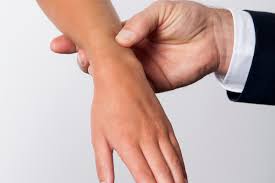When the X-Ray Lies: How Marma and Ayurvedic Chiropractic Revived a Misdiagnosed Wrist Fracture and Dislocation Management Through Touch, Intuition, and Time-Tested Healing
- Dr Rakesh VG
- Jul 31
- 3 min read
Updated: Aug 1
By Dr Rakesh Ayureshmi, Ayureshmi Ayurveda Wellness Centre, Kollam, Kerala, India

When Machines Miss, the Hands Remember
In an era where imaging dominates diagnostics, what happens when the machine fails? A young laborer, misdiagnosed with a wrist sprain by an orthopedic surgeon who trusted the X-ray, remained in agony for months. But a single session with a trained Marma and Ayurvedic chiropractic practitioner revealed the truth: a dislocated radioulnar joint. With bare hands and traditional wisdom, the joint was realigned—pain vanished, function returned.
This case is not an anomaly. It is a wake-up call to revisit the diagnostic power of sparsha pareeksha (palpation) and the healing science of Marma chikitsa in fracture and dislocation management, especially in rural India where both technology and trust in the body coexist.
Beyond the Bone: The Forgotten Touch in Orthopedic Healing
The Ayurvedic View on Fractures and Dislocations: Bhagna Chikitsa
Ancient Ayurvedic texts like Sushruta Samhita detail Bhagna (fractures) and Sandhi-mukta (dislocations) with remarkable clarity. Sushruta classifies fractures into twelve types, from Karkata (comminuted) to Churnita (crushed), along with methods for their reduction, immobilization, and healing. He emphasized:
Palpation and inspection over imaging
Oil massage and bandhana (bandaging) for healing
Internal herbal medications and suppliments for osteogenesis
Dislocations (Sandhimukta) were understood not just as joint displacement but as marma vyatha—disturbance in the body’s vital force centers.
Marma: The Diagnostic Radar Hidden in Our Hands
Marma points are not just therapeutic targets—they are diagnostic indicators. When palpated skillfully, they reveal blockages, displacements, and internal derangements even when X-rays or MRIs fail.
“Marma is where the consciousness meets the flesh.” – Charaka
In wrist injuries, Manibandha marma (located at the wrist junction) is often the key diagnostic site. Tenderness, asymmetry, or altered pulsation here may signal subluxation or dislocation even in absence of fracture on X-ray.
In the case of the misdiagnosed wrist dislocation, the patient’s persistent deep pain, crepitus, and limited pronation-supination were red flags. A thorough palpation revealed that the distal radioulnar joint was out of alignment—a condition missed by the radiograph.
Chiropractic Integration in Ayurveda: A Perfect Symbiosis
Although Western chiropractic care is a recent import, the philosophy of structural realignment is ancient in India.
Marma chikitsa manipulates energy points to realign subtle and gross anatomy.
Ayurvedic bonesetters (bhagna vaidyas) traditionally perform realignments using manual pressure, traction, and muscle balancing techniques.
Ayur-Chiro Fusion: Combining Ayurvedic oils, fomentation, muscle relaxation, and joint manipulation creates an integrative protocol far more nuanced than conventional orthopedics.
Recent studies validate this approach. A 2022 study in The Journal of Manual & Manipulative Therapy found that manual palpation by trained practitioners outperformed imaging in diagnosing minor joint subluxations, especially in the wrist and ankle.
The Treatment Protocol: Beyond Cast and Cut
A typical integrative Ayurvedic protocol for misdiagnosed wrist dislocation involves:
1. Palpation and Realignment:
Gentle traction and rotational correction of the radioulnar joint using marma guidance.
2. Medicated Oil Application:
Oils like Murivenna or Dhanwantharam Taila to soothe inflamed tissues and restore vata balance.
3. Bandhana (splinting):
Not rigid casting, but flexible bandaging that allows circulation and marma access.
4. Internal Medicines for
– Bone healing
– Strength and regeneration
– Anti-inflammatory and immunomodulatory
5. Diet and Lifestyle:
Bone-forming diet rich in calcium, sesame, ghee, and sleep discipline to assist dhatu pachana (tissue digestion and reconstruction).
When the System Fails, the Senses Heal
The case of the misdiagnosed wrist is not an isolated one. A 2019 study in The Indian Journal of Orthopaedics reported a 26% rate of misdiagnosed dislocations in peripheral joints due to over-reliance on imaging and underuse of physical examination.
In contrast, traditional Ayurvedic marma experts rely on decades of trained touch—a skill slowly disappearing in modern clinical practice. Their expertise is particularly vital in:
Pediatric fractures where growth plates confuse imaging
Ligamentous injuries invisible on X-ray
Rural and emergency setups where scans are unavailable
Conclusion: It's Time to Feel Again
Healing isn’t always visible on a screen. It often lies beneath the skin, in the intelligent pulse of marma, in the intuition of the healer’s hands, and in the wisdom of ancient protocols designed to treat the whole being—not just the bone.
As fractures and dislocations continue to be over-imaged and under-touched, it's time to ask:
What did we lose when we replaced fingers with films?
Let us reclaim the power of therapeutic touch, marma awareness, and Ayurvedic insight—not just for better diagnosis but for more human, heartfelt healing.
"A misdiagnosed wrist dislocation healed without surgery—thanks to the wisdom of Marma and Ayurveda. When X-rays fail, touch speaks.
Let’s bring back the ancient art of healing by hands."




Comments